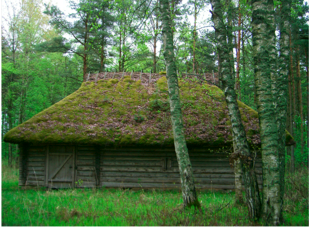Chapter 21. Tiiu [October 5, 1347]
Cultural Explanations
 |
Chapter 21. Tiiu [October 5, 1347] Cultural Explanations |
|
|
In this chapter Bávlos hears the views of a local peasant woman regarding the Orden and the Danes. | ||
| Tiiu |
In this chapter, Bávlos hears the Estonian side of the story of Baltic Christianization. Naturally, it differs a good deal from what the priest told him in German. The forced conversion of the Baltic peoples was by all accounts a harsh and unjustifiable process, and Tiiu does not mess words about it. Of course, as is so often the case, religion was used here as a cloak behind which to conceal a process of seizing land and enslaving people that had no real relation to Christian morals. Eventually, church authorities would condemn the practices of the Teutonic Knights, but not after some centuries of permitting these injustices to occur in the name of the faith.
Bávlos is surprised to discover that Tiiu speaks a language similar to Sámi and Finnish. Compare her Estonian sentence with its equivalents in North Sámi and Finnish:
(Estonian) Sina ole keeletarkk.
(North Sámi) Don leat gielládárki.
(Finnish) Sinä olet kielitarkka.
As you can tell, Estonian and Finnish are very similar, and Northern Sámi is a little less familiar. Yet Bávlos, having learning Finnish, and having a natural (supernatural?) gift for languages, understands Tiiu's speech with little difficulty.
Bávlos also notices other affinities between Estonian culture and Sámi: the male/female division of the living quarters, the quiet interactions, the penchant for expressive singing. Here are some images of a traditional Estonian cottage from the wonderful open air museum near Tallinn. This is the sort of house that Tiiu brings Bávlos to visit.
 |
 |
 |
| detail, thatch covered in moss | low thatched cottage, note lack of windows | smoke hole in roof for escape of smoke |
The concept of a supernatural ability with language, by the way, is a detail that appears in the Estonian national epic Kalevipoeg, in which the Sámi hero Varrak is said to possess this skill. So keeletarkk is really an Estonian concept, and I imported it into my story about Bávlos from Estonian tradition. It has always interested me that the Estonian epic includes a Sámi character, even if Varrak is not altogether a positive character in the narrative. He appears first in Poem 16 of that epic and recurs in Poem 19.
Tiiu relates events and details that are important in Estonia at this time. The native Estonians did indeed rise up against Danish rule on the Feast of St. George, and their uprising lasted from 1343 to 1345. You can read all about the uprising HERE. The Danish authories, led by Stig Andersen, were confined to their fortress at Reval until the Teutonic Knights invaded to liberate them. The sale of Estonia to the Knights occurred soon after, for the price mentioned by Tiiu—19,000 coins of Cologne. The formal transfer of the lands to the control of their new owners took place on November 1, 1346, i.e., less than a year before Bávlos's visit. So naturally, these events are still quite raw in everyone's memory, and the intensity I portray in this and the previous chapter is probably fairly accurate for the time.
Tiiu's song of what happens in the afterlife to the Estonian serf and the evil ruler is my translation of a traditional Estonian song included in the multilingual anthology of Finno-Ugric songs The Great Bear: A Thematic Anthology of Oral Poetry in the Finno-Ugrian Languages (Ed. Lauri Honko, Senni Timonen, and Michael Branch; Helsinki: Finnish Literature Society, 1993, no. 274, pp. 394-5). In the text here, I have translated the song so as to illustrate the rich alliterative patterns that characterize traditional Estonian (and Finnish) songs. The image of saved and damned seeing each other in the afterlife parallels the biblical account of Lazarus and the rich man (Luke 16:19-31). One may note that Tiiu does not seem any friendlier toward the Orden than the priest in Reval seems toward the native Estonians. Both view themselves as on Christ's side against the other.
Tiiu calls Reval by its Estonian name Taannilinn, i.e., "Danish fort/city". This is the etymology of the placename Tallinn, the modern name for the great Hanseatic city and capital of Estonia.
The night of October 5, 1347 continues in the next chapter!